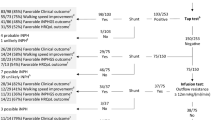Abstract
Gait disturbance is the most common symptom in idiopathic normal-pressure hydrocephalus (iNPH). However, its pathophysiology in iNPH has not been clarified. Some researchers have hypothesized that the mesencephalic locomotor region, which is a functionally defined area in the brainstem playing an important role in locomotion, is involved in the development of gait disturbance in iNPH. The purpose of the study was to investigate whether the midbrain is involved in the manifestation of gait disturbance in iNPH. Twenty-one iNPH patients who showed clinical improvements after shunt surgery were studied. Brain magnetic resonance imaging (MRI) was performed and clinical symptoms were assessed before and 1 year after surgery. Gait disturbance was assessed by the Timed Up and Go test and gait subcategory of the iNPH Grading Scale, a validated assessment tool for iNPH symptoms. Anteroposterior, left-to-right diameter and cross-sectional areas of the midbrain were measured at the inferior collicular level of axial images in MRI. The diameters and cross-sectional area of the midbrain at baseline did not show significant correlation with gait assessments at baseline (Spearman’s correlation). The midbrain measurement did not show significant difference between the baseline and postoperative values (paired t test), and its change rates did not show significant correlation with the change (rates) of the gait assessments. In this study there were no findings to suggest involvement of the midbrain in the manifestation of gait disturbance in iNPH. The hypothesis that the mesencephalic locomotor region is involved in the manifestation of gait disturbance in iNPH needs to be reconsidered.


Similar content being viewed by others
References
Hakim S, Adams RD (1965) The special clinical problem of symptomatic hydrocephalus with normal cerebrospinal fluid pressure. Observations on cerebrospinal fluid hydrodynamics. J Neurol Sci 2:307–327
Adams RD, Fisher CM, Hakim S, Ojemann RG, Sweet WH (1965) Symptomatic occult hydrocephalus with “normal” cerebrospinal-fluid pressure: a treatable syndrome. N Engl J Med 273:117–126
Boon AJ, Tans JT, Delwel EJ, Egeler-Peerdeman SM, Hanlo PW, Wurzer HA, Hermans J (2000) The Dutch normal-pressure hydrocephalus study. How to select patients for shunting? An analysis of four diagnostic criteria. Surg Neurol 53:201–207
Krauss J, Droste D, Vach W, Regel J, Orszagh M, Borremans J, Tietz A, Seeger W (1996) Cerebrospinal fluid shunting in idiopathic normal-pressure hydrocephalus of the elderly: effect of periventricular and deep white matter lesions. Neurosurgery 39:292–299 (discussion 299–300)
Krauss J, Regel J, Vach W, Droste D, Borremans J, Mergner T (1996) Vascular risk factors and arteriosclerotic disease in idiopathic normal-pressure hydrocephalus of the elderly. Stroke 27:24–29
Mori K (2001) Management of idiopathic normal-pressure hydrocephalus: a multiinstitutional study conducted in Japan. J Neurosurg 95:970–973
Stolze H, Kuhtz-Buschbeck JP, Drucke H, Johnk K, Illert M, Deuschl G (2001) Comparative analysis of the gait disorder of normal pressure hydrocephalus and Parkinson’s disease. J Neurol Neurosurg Psychiatry 70:289–297
Miyoshi N, Kazui H, Ogino A, Ishikawa M, Miyake H, Tokunaga H, Ikejiri Y, Takeda M (2005) Association between cognitive impairment and gait disturbance in patients with idiopathic normal pressure hydrocephalus. Dement Geriatr Cogn Disord 20:71–76
Owler B, Momjian S, Czosnyka Z, Czosnyka M, Péna A, Harris N, Smielewski P, Fryer T, Donovan T, Coles J, Carpenter A, Pickard J (2004) Normal pressure hydrocephalus and cerebral blood flow: a PET study of baseline values. J Cereb Blood Flow Metab 24:17–23
Jenkinson N, Nandi D, Muthusamy K, Ray N, Gregory R, Stein J, Aziz T (2009) Anatomy, physiology, and pathophysiology of the pedunculopontine nucleus. Mov Disord 24:319–328
Lee P, Yong S, Ahn Y, Huh K (2005) Correlation of midbrain diameter and gait disturbance in patients with idiopathic normal pressure hydrocephalus. J Neurol 252:958–963
Mocco J, Tomey MI, Komotar RJ, Mack WJ, Frucht SJ, Goodman RR, McKhann GM II (2006) Ventriculoperitoneal shunting of idiopathic normal pressure hydrocephalus increases midbrain size: a potential mechanism for gait improvement. Neurosurgery 59:847–850 discussion 850–851
Ishikawa M, Hashimoto M, Kuwana N, Mori E, Miyake H, Wachi A, Takeuchi T, Kazui H, Koyama H (2008) Guidelines for management of idiopathic normal pressure hydrocephalus. Neurol Med Chir (Tokyo) 48(Suppl):S1–S23
Kubo Y, Kazui H, Yoshida T, Kito Y, Kimura N, Tokunaga H, Ogino A, Miyake H, Ishikawa M, Takeda M (2008) Validation of grading scale for evaluating symptoms of idiopathic normal-pressure hydrocephalus. Dement Geriatr Cogn Disord 25:37–45
Podsiadlo D, Richardson S (1991) The timed “Up & Go”: a test of basic functional mobility for frail elderly persons. J Am Geriatr Soc 39:142–148
Rasband W (1997) ImageJ. [http://rsb.info.nih.gov/ij/] website National Institutes of Health, Bethesda, Maryland, USA
Acknowledgments
This work was partly supported by a Research Grant from the Ministry of Health, Labour and Welfare of Japan (2008-Nanchi-17).
Author information
Authors and Affiliations
Corresponding author
Rights and permissions
About this article
Cite this article
Hiraoka, K., Yamasaki, H., Takagi, M. et al. Is the midbrain involved in the manifestation of gait disturbance in idiopathic normal-pressure hydrocephalus?. J Neurol 258, 820–825 (2011). https://doi.org/10.1007/s00415-010-5847-2
Received:
Accepted:
Published:
Issue Date:
DOI: https://doi.org/10.1007/s00415-010-5847-2




